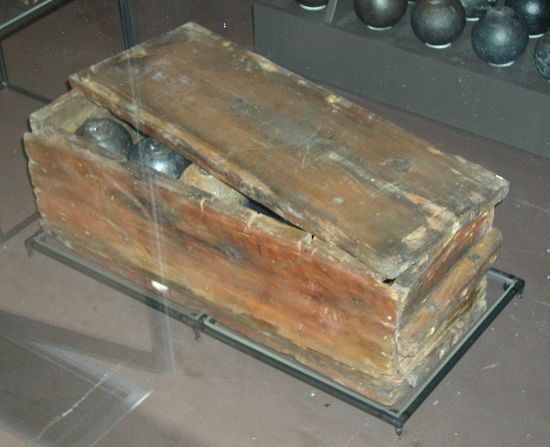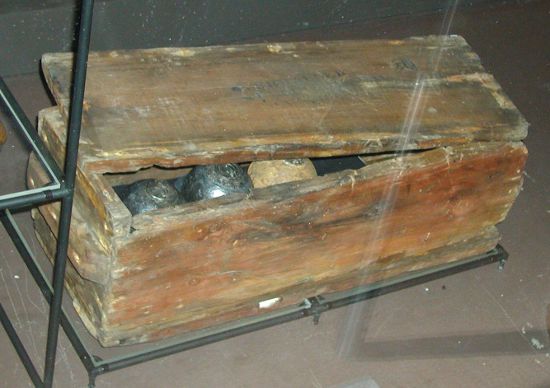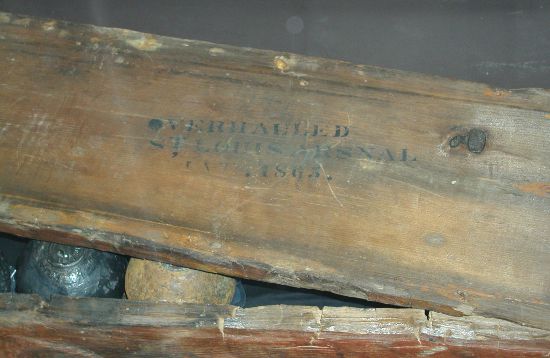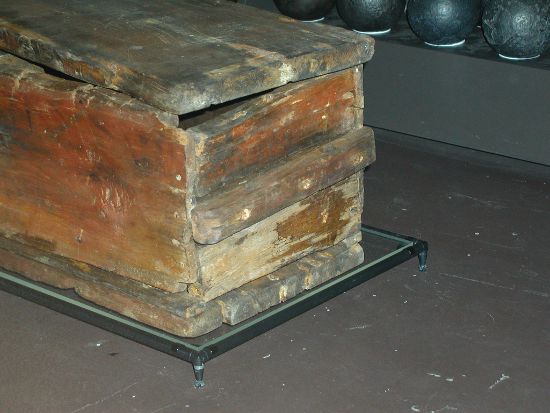The Steamboat Bertrand Museum
Mountain Howitzer Ammunition Packing Boxes
by Randy Baehr
In addition to its commercial stores, the Bertrand carried packing boxes of mountain howitzer ammunition, both spherical case and canister rounds. Rounds were packed in the boxes in two rows of six, projectile down and powder bag up. The rounds were the typical fixed howitzer round with a tapered sabot to accommodate the chamber in the breech of the tube. The dimensions of several of the boxes have been documented as part of the preservation efforts. Some dimensions apparently vary from the original due to shrinkage of the white pine wood from over a century of submersion.
Measurements:
Case interior: 27 1/2″ length x “approximately” 9″ width x 8 3/4″ high
(12 pdr. howitzer shot was 4.52″ in diameter; two wide would be 9.04″; six long would be 27.12″)
Case exterior: 29 3/4″ length x 11 1/2″ width x 12″ high
(This produces a wood thickness of 1 1/8″. The Ordnance Manual specifies 1 1/4″ stock; the difference is attributed to shrinkage of the artifact.) The bottom plate was attached to the sides with 9 nails down the long sides and 5 nails down the short sides through the bottom plate into the sides and ends. The end plates were nailed to the long sides with four nails into the sides through the end plates and four nails into the end plate mortises through the sides. The lid was attached with two nails into the end plates and three nails into the sides.
Case handles were 11 3/8″ width x 1 3/8″ high by 1″ depth on one example, 11 3/8″ x 1 1/2″ high by 1 1/8″ depth on another. One case had handles that were rounded off on both ends of the handle, and one had handles that were rounded on one end and squared off on the other. Both had 3/4″ holes for rope handles 4 1/4″ apart. The handles were attached to the box ends about 1 3/4″ from the upper edge (assumedly of the end plate without the lid in place) with three nails or screws of a 7/16″ diameter that did not go all the way through the end plates into the interior of the box.

For display purposes, the rounds are shown shot up in the box, although the Arsenal would have packed them shot down.
Markings:
The Museum Catalog record for one case shot box states: “Stenciled on the interior of [the lid] is: ‘OVERHAULED / ST. LOUIS ARSN_’ and ‘1865’. This box was “quite dark, probably due to black paint. There seems to be evidence of red paint as well.” The end pieces were painted red with black stenciled lettering, now indecipherable. This is consistent with our information that spherical case boxes were painted red. The record notes that this box had more nail holes in the top edges of the sides than there were in the accompanying lid, suggesting that the box had be reused.
The record for another case shot box says: “On case end in white stenciled ‘Gothic’ type style: ‘[12].12 PDR.. MOUNT / HOWITZER / [undecipherable] FIXED / [undecipherable]’. First line and last line of text extends to edge of case lid and bottom. On case end in white stenciled ‘Gothic’ type style: ‘12.12 PDR. MOUNT’ above handle; ‘[SHELLS] FIXED / FEBR. 1865’ below handle. First line extends to edge of case lid, last line extends to area of wood loss in case end. On case side in faint white stenciled ‘Gothic’ type style ’18 FRICTION PRIMERS’. Illegible below this line (according to field record) ‘FROM ST. LOUIS ARSENAL’.
Supplemental Note
The relevant sections of John Gibbon’s 1863 Artillerist’s Manual include the following:
The kinds of wood principally used in ordnance constructions are the following:
White Pine is used for arms-chests and packing-boxes generally, and for building purposes. (p. 104)
Packing.- Field ammunition is packed in boxes of well seasoned stuff, 1 1/4 in. thick and dove-tailed at the corners. The cover is fastened with screws, and a rope handle attached to a bracket is fixed at each end. The boxes are painted olive color on the outside, and the kind of ammunition is marked on both ends in large white letters. The place and date of fabrication are marked on the inside of the cover. (p. 409)
This article was originally published in the September 2002 issue of The Shrapnel, the newsletter of the Turner Brigade. For information about The Shrapnel, contact Sheila Porter, Editor.




